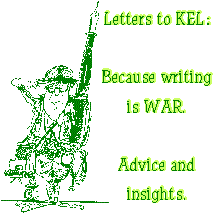Letters to Kel: GET TO THE END!
 You can't have a booksigning without a published book.
You can't have a booksigning without a published book.Makes sense, right?
You can't have a published book until you've gone through the torturous editing process with your editor.
Can't have the editing until you sell the book.
Can't sell the book until you send it to the editor -- and you can't send it until you query and gain the editor's interest.
You can't query a book until you have one to send in!
Of course, once you're a published author, you can work up to the point where you can simply say to your publisher, "I have this idea ..." and essentially sell the book before you write it. But that takes time.
What am I getting at? Bear with me...
You have to have a finished book to query it (until you're so successful that people are clamoring to buy scribbled notes on a wet napkin).
So FINISH the dang book!
To finish the book you have to do multiple revisions and polishes.
You can't revise and polish a book until you ... that's right, say it along with me ... FINISH that first draft.
I have a friend who I consider a much better writer. She has hundreds of scenes scribbled out for dozens of possible books. Lovely bits of dialogue and action, and plot movement ... but those dozens of scenes haven't been sewn together into a cohesive whole.
You probably have writing friends who do the same thing. Or maybe you're the one with the problem. "But I want the scene to be PERFECT before I go on to the next one."
Excuse me, but that's what REVISIONS are for. Sometimes I only have a general idea where the book is going. I have a beginning and an end in sight, but the journey from A to B is kind of misty. I wander a lot. The wandering is the FUN part of the process. Getting to know your characters, their pasts and foibles and fears. Going off on tangents. Discovering things you didn't know or didn't even imagine about your characters when you first sat down to write the book.
Can't go on that journey until you get moving. So what if the scene you just finished writing doesn't feel right, there are missing pieces, you're not sure where it belongs in the story? Keep moving, and give yourself permission to do a half-baked scene and go on to the next one. You might just find out what you need to fix scene 27 when you get to scene 35. Something happens in scene 41, and you realized you need to go back and drop hints and insert props and create a new character in scenes 4, 15, and 23. So make some notes of what to do and KEEP WRITING. Get to the end of the book. When you have a better idea of what's going to happen, and what you need to have happen, and what needs to be foreshadowed and what needs to be cut, then you go back and REVISE. The first draft is the skeleton, not the final product.
Give yourself permission to write a first draft (not part of a first draft, but the whole thing) that is so utterly wretched, if you printed it out and lined a bird cage, the bird would die.
You can only get better from there. And isn't that a good feeling?
FINISH THE DRAFT YOU'RE WORKING ON. Doesn't have to be perfect, just has to be enough to revise and add to. You can fix a bad scene, but you can't fix a blank page ... except by writing on it.
Published on September 04, 2014 02:00
No comments have been added yet.



